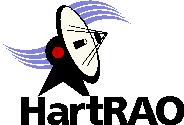
HartRAO Home >
news >
CONT14 15 days continuous geodetic VLBI 2014-05-06
CONT14 15 days continuous geodetic VLBI 2014-05-06
Every three years a two-week long continuous geodetic VLBI session has been
held to test advances in the technique. The latest in this series is called
CONT14 and runs from 6 to 20 May 2014. Detailed information about it can be
found on the CONT14
Observing Campaign webpage. It supports high resolution Earth rotation
studies, investigations of reference frame stability, and investigations of
daily to sub-daily site motions and more. It makes use of 17 radio
telescopes on six continents.
The HartRAO 26m telescope participated in the previous CONT02, CONT05,
CONT08 and CONT11 experiments.
This time, the 15m telescope is being used
for CONT14. There is a live webcam aimed at the 15m
telescope.
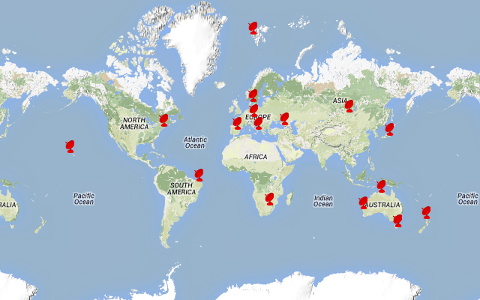
Left click on image for large version.
Credit: Arnaud Collioud,
Laboratoire d'Astrophysique de Bordeaux / CNRS, France
http://ivslive.obs.u-bordeaux1.fr
The stations operating in CONT14 are shown in the map above and comprise:
Badary (Russia), Fortaleza (Brazil), Hartebeesthoek 15m (South Africa), Hobart 12m
and Hobart 26m (Tasmania, Australia), Katherine (Australia),
Kokee Park (Hawaii, USA), Matera (Italy), Ny Alesund (Spitzbergen, Norway), Onsala
(Sweden), Tsukuba (Japan), Warkworth (New Zealand), Westford
(Massachusetts, USA),
Wettzell (Germany), Yarragadee (Australia), Yebes 40m (Spain), Zelenchukskaya
(Russia).

Left click on image for large version. Credit: M Gaylard / HartRAO
2014 May 06 - Pieter Stronkhorst started the CONT14 observing at HartRAO at 2am local
time

Left click on image for large version. Credit: M Gaylard / HartRAO
2014 May 06 - The 15m radio telescope at HartRAO is being used for CONT14.
It was originally built as the first prototype in developing the Karoo Array
Telescope. Compared to
the 26m telescope, its rapid slew rate and ability to observe down to the
horizon in all directions make it more suitable for geodetic VLBI.
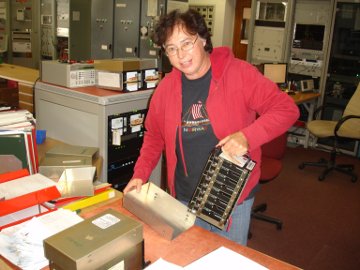
Left click on image for large version. Credit: M Gaylard / HartRAO
2014 May 06 - Geodetic VLBI support officer Marisa Nickola in the telescope control room checking a disk pack for data recording for CONT14.
The Mark 5B recording system and Digital Baseband Converter for the 15m
telescope are to her left.
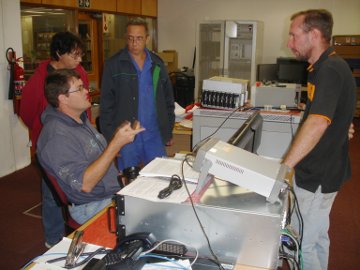
Left click on image for large version. Credit: M Gaylard / HartRAO
2014 May 06 - VLBI Manager Jonathan Quick briefs Marisa Nickola, Jacques
Grobler who will run the second night shift, and Pieter Stronkhorst, who ran
the first shift.
During geodetic VLBIs, subsets of the full set of telescopes observe each source, with
two or more sources usually being observed simultaneously by different
subsets. The maps below show some
of the subsets during the first day of CONT14. These maps are taken from
the IVS Live
website, where the
progress of all geodetic VLBIs run by the International VLBI Service for
Geodesy and Astrometry can be followed live.
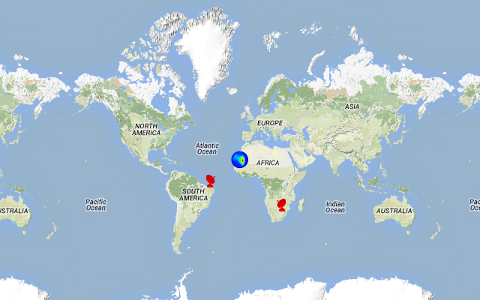
Left click on image for large version.
Credit: Arnaud Collioud,
Laboratoire d'Astrophysique de Bordeaux / CNRS, France
http://ivslive.obs.u-bordeaux1.fr
2014 May 06 - Radio source 0229+131 being observed by Forteleza, Brazil, and
Hartebeesthoek, South Africa. The source was directly above the spot marked
with a false-colour radio image of a quasar.
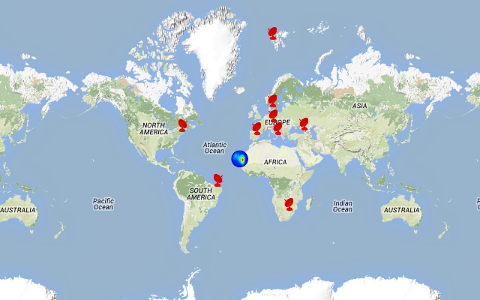
Left click on image for large version.
Credit: Arnaud Collioud,
Laboratoire d'Astrophysique de Bordeaux / CNRS, France
http://ivslive.obs.u-bordeaux1.fr
2014 May 06 - Radio source 0229+131 being observed a little later by a much larger
subset of the telescopes in North and South America, Africa and Europe.
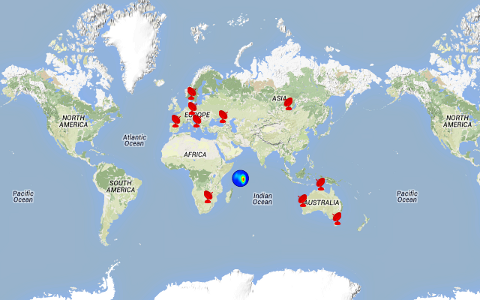
Left click on image for large version.
Credit: Arnaud Collioud,
Laboratoire d'Astrophysique de Bordeaux / CNRS, France
http://ivslive.obs.u-bordeaux1.fr
2014 May 06 - Radio source 0727-115 being observed by telescopes in Africa,
Europe, Asia and Australia.
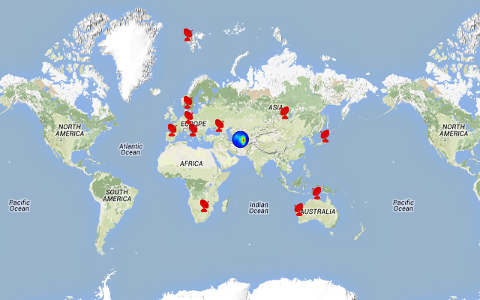
Left click on image for large version.
Credit: Arnaud Collioud,
Laboratoire d'Astrophysique de Bordeaux / CNRS, France
http://ivslive.obs.u-bordeaux1.fr
2014 May 06 - Radio source 0738+313 being observed by a large subset of the
telescopes, in Europe, Africa,
Australia and Asia.
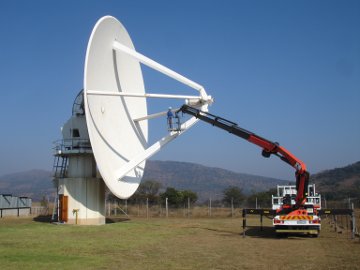
Left click on image for large version. Credit: M Gaylard / HartRAO
2014 May 08 - After a foggy early morning, condensation had to be removed from the
diaphragm over the feed aperture of the S-X receiver on the 15m telescope.
Pieter Stronkhorst is seen here on his way up to the receiver during the
scheduled maintenance period at 09h00 local time.
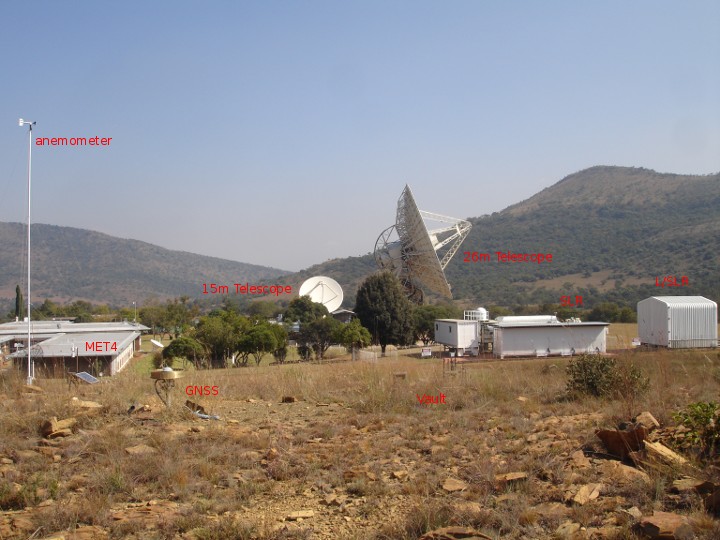
Left click on image for large version. Credit: M Gaylard / HartRAO
2014 May 08 - HartRAO is one of few sites in CONT14 to have co-located Global Navigation Satellite
System (GNSS)
base-station receivers, a satellite laser ranger, and a (nearby) DORIS
system, which adds to its value. The geodetic instruments on site at HartRAO are shown here.
From the left we have the mast-mounted anemometer, the MET-4 weather
station, the GNSS base-station antenna
in the foreground, the 15m telescope observing in CONT14, the 26m telescope,
the underground vault for geodesy instruments (gravimeter, sesimometer), the
NASA MOBLAS-6 satellite laser ranger, and the lunar/satellite laser ranger
in construction.

Left click on image for large version. Credit: M Gaylard / HartRAO
2014 May 08 - The MOBLAS-6 satellite laser ranger is seen here tracking the AJISAI
satellite. Laser pulses are fired at the satellite and corner
reflectors mounted on it return the signal to the SLR's telescope. The
round-trip travel time of
the pulses provides a measure of the (constantly changing) distance to the satellite with a
precision of about 1 cm as it moves across the sky.
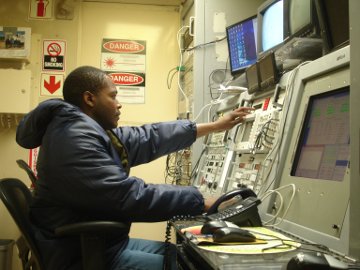
Left click on image for large version. Credit: M Gaylard / HartRAO
2014 May 08 - SLR Technical Manager Lusanda Ntsele is seen inside the
MOBLAS-6 control room optimising the tracking by the SLR of the AJISAI satellite as it
moves across the sky.
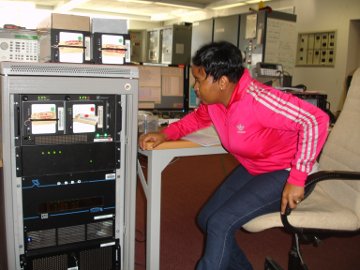
Left click on image for large version. Credit: M Gaylard / HartRAO
2014 May 08 - Late afternoon and electronics technician Charity Zondi checks
the disk parks in the Mark 5B recorder as she
prepares to look after CONT14 for the night.
CONT14 ended after 15 days, on Tuesday May 20 at 02h00 local time in South
Africa.
During CONT14 a total of 6217 observations of radio sources, or "scans" were scheduled over
the period for the HartRAO 15m telescope. This is an average of 414 scans
per day. Of the total scans, it is estimated that 36 were lost to technical
issues, mainly clock jumps. This translates to a success rate of 99.4%.
By contrast, CONT11 made use of the HartRAO 26m telescope. This has lower
maximum drive speeds than the 15m telescope. In CONT11 the 26m telescope
carried out an average of 311 scans per day. The success rate in CONT11 was
also 99.4%, but the causes of data loss were different.





